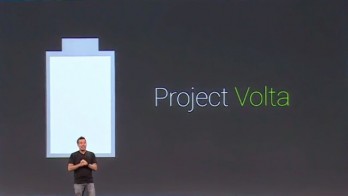Normally, when software developers talk up battery-saving features in their operating systems, the gains are relatively modest. Microsoft spent a great deal of time telling everyone how Windows 8 would introduce a great many new features designed to save power and boost runtime, but follow-up tests demonstrated that the company still lags Apple by a huge amount — even after patching the Surface Pro’s firmware. Google, however, appears to be playing in a different field — the company’s Project Volta, which aims to boost Android battery runtime, is giving incredible results.
According to Ryan Whitwam over at Geek.com, the Project Volta update baked into Android L yields impressive battery life improvements by shifting how tasks are scheduled. Ars Technica recently took the OS for a spin and measured a huge increase at constant display brightness — the Nexus 5 went from 345 minutes to 471 minutes in the exact same battery test. According to Ars, that test involves reloading the same web page over and over until the WiFi battery dies.
How much can Volta help?
So far, Ars appears to be the only publication that’s directly tackled this testing, so our insight into what general users can expect is limited. Presumably the device is saving power by either shutting the WiFi radio off more quickly after the page load is complete. Some of the improvements made to Android L could also be responsible for this — the new version uses Google’s ART runtime rather than the older Dalvik runtime. This means that instead of compiling code every time it runs, applications are compiled once and stored. This, in turn, means it’s more useful to squeeze out every last performance and architectural optimization. Cores that spin up and spin back down more quickly also intrinsically use less power, which may account for some of the operating system’s improvement.
The key question is going to be how many of Volta’s improvements apply to general use-cases. There are a number of ways to potentially boost web performance, from better WiFi power cycling to more efficient browser performance, to more aggressive data caching leading to fewer reloads (though the Ars folks may have forced a net connection every 15 seconds). I wouldn’t expect Volta to improve power consumption in every case — workload power use always depends on what you’re doing, and some areas improve more quickly than others. Similarly, Volta isn’t going to breathe new life into a battery that’s tottering on its last legs.
Still, even with some qualifiers behind it, a 36% improvement in battery life bodes well for almost everybody. Here’s hoping the figure applies to all Android devices equally. That’s another question we don’t have the answer to, yet: even among the devices that can upgrade to Android 4.4, will vendor-specific optimizations help or hinder the battery life improvements that Volta brings to the table?






